
1 minute read
Geoscience and public health
GEOSCIENCE AND
PUBLIC HEALTH
Medical geology is a multi-disciplinary field of research into the close relationship between human health and the naturally occurring elements, minerals, and organic compounds that are found in land, water, and air.
The two main goals of medical geology are to 1) quantify naturally occurring background variations of elements in the environment (including soil, water, sediments, and air) to provide a better understanding of the changes that pollution imposes, and 2) understand the risks and benefits of naturally occurring geological elements and minerals to people and organisms. For example, medical geology researchers study the occurrence of radon, which may infiltrate into homes from underlying uranium-rich rocks and glacial deposits. Others are concerned with inhalation of airborne mineral dusts, or drinking water from deep wells, which may be impacted by arsenic sulphides in the surrounding bedrock.
Advances in medical geology research rely on effective collaboration amongst earth and environmental scientists, geochemists, toxicologists, epidemiologists, and medical practitioners, including veterinarians. The success of these collaborative efforts ultimately depends on effective communication of risks and benefits to the Canadian public. The value of medical geology research in Canada is evidenced by the growing public awareness of the many influences of geology on the quality of indoor and outdoor environments.
DID YOU KNOW
Some elements found naturally in geological sources, such as selenium, can be both essential and toxic to humans and animals depending on the concentration and the form of the element.
Selenium is particularly important to the health of grazing livestock. In some areas of Canada, selenium enters the food chain in high concentrations from geological sources, providing this much-needed nutrient. In other areas, selenium deficiencies occur and livestock may require dietary supplements.
For humans, selenium is an essential nutrient at low levels. However, at concentrations that are too high, selenium may result in damage to the nervous system; fatigue and irritability; and, when the exposure is long term, may cause more severe health issues.
FBY











